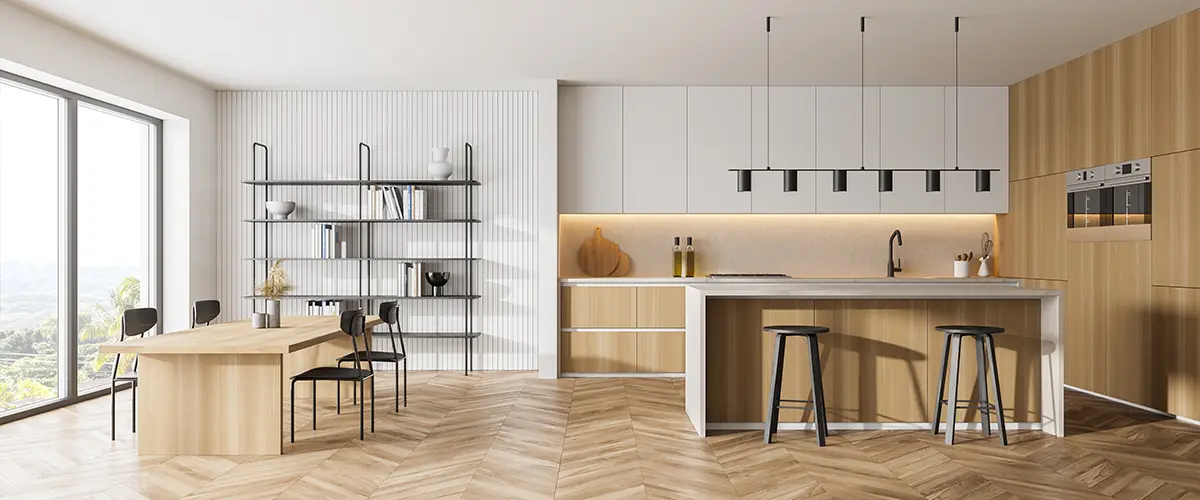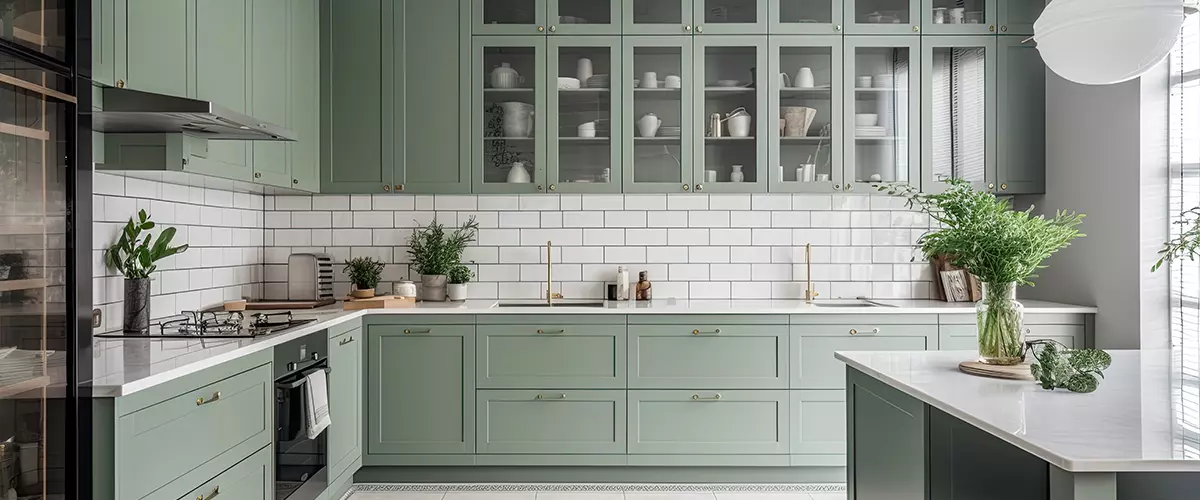Melamine Vs Laminate For Cabinets
Deciding on the right material for your kitchen cabinets can be tricky. Melamine and laminate are popular choices, yet they differ in significant ways.
This article will guide you through understanding these materials, comparing melamine and laminate for cabinet use specifically.
Keep reading to make an informed decision that suits your home best!

Laminate vs Melamine: What Differentiates Them?
Laminate cabinets are constructed with a plastic coating over plywood while melamine cabinets consist of paper and resin glued onto particleboard.
These different materials affect the durability, aesthetics, and cost of each type of cabinet.
Laminate cabinets
Laminate cabinets are popular for their versatility and the wide range of finishes they offer. They consist of layers of plastic laminate bonded to a plywood or particleboard core, creating a sturdy surface that resists scratches and stains well.
These cabinet surfaces come in various colors and patterns, allowing you to mimic the appearance of wood or other materials without the higher cost.
If you’re looking for durability in kitchen cabinetry, laminated options might be your best bet. The outer layer protects against daily wear while being easy to clean with just a damp cloth.
Edge banding is applied to seal the joints against moisture, reducing the risk of warping over time—making laminate an excellent choice for busy households where function needs to meet form.
Melamine cabinets
Shifting focus from laminate, melamine cabinets offer a different set of benefits for kitchen cabinetry. They feature a core of particleboard or MDF, which is then covered with a paper and resin finish to mimic the look of wood or other textures.
Melamine stands out for its smooth surface that’s easy to clean and relatively resistant to scratches. The material’s construction process involves pressing the paper-resin layer onto the board under high heat and pressure, ensuring that it adheres firmly.
Homeowners appreciate melamine cabinet doors because they come in various colors and patterns, allowing for personalized kitchen design options without breaking the bank. Plus, these cabinets typically have better moisture resistance compared to traditional wood veneer cabinets.
Edge banding can be applied to conceal the raw edges where the melamine meets the core material, giving your cabinetry a seamless look that enhances durability further.
Upgrade Your Kitchen With High Sierra Cabinets
Don’t compromise on quality or aesthetics; contact us today to discover how we can bring your dream kitchen to life with our expert cabinet solutions. (775) 242-6832

Melamine Vs Laminate for Cabinets: What are the Differences?
When it comes to material composition, melamine cabinets are made with a resin-saturated paper that is thermally fused onto a substrate, while laminate cabinets are constructed with multiple layers of kraft paper and a plastic resin.
In terms of durability, melamine cabinets offer excellent moisture resistance and are easy to clean, but laminate cabinets tend to be more resistant to scratches and impact.
Additionally, melamine may have lower resale value compared to laminate due to its perceived lower quality aesthetics.
Material composition
Melamine cabinets are composed of a resin-saturated paper layer that is heat-fused to an engineered wood core. This construction creates a durable and moisture-resistant surface, making melamine cabinets suitable for kitchens and bathrooms.
On the other hand, laminate cabinets consist of multiple layers of kraft paper soaked in plastic resin, bonded together under high pressure. The top layer is then printed with a decorative pattern or color.
This process results in a hard-wearing, scratch-resistant surface that is easy to clean and maintain.
Durability
For cabinets, durability is crucial in ensuring longevity and resilience against daily wear and tear. Laminate cabinets are known for their durability, as the hard plastic surface resists scratches, dents, and moisture damage effectively.
This makes them an excellent choice for busy kitchens or high-traffic areas where resilience is essential. On the other hand, melamine cabinets also offer impressive durability due to their resistance to heat, stains, and impact.
The added layers of resin provide a tough exterior that can withstand regular use without showing signs of deterioration.
Resale value
When considering the resale value of your home, it’s essential to choose cabinet materials that will stand the test of time. Both melamine and laminate cabinets can positively impact the resale value due to their durability and low maintenance requirements.
Homebuyers often value cabinets that are in good condition, and both melamine and laminate options offer long-lasting appeal without significant wear or damage.
Potential buyers are more likely to be attracted to homes with modern, well-maintained cabinetry, whether it’s made from melamine or laminate.
Opting for high-quality materials like these can increase the perceived value of your property, making it a smart investment if you plan on selling your home in the future.
Aesthetics
Melamine cabinets offer a smooth and consistent finish that emulates the look of real wood grain, with a wide range of colors and patterns to choose from. With advancements in technology, melamine cabinets now come in a variety of textures including matte, glossy, and even realistic wood-grain finishes.
On the other hand, laminate cabinets are also available in an assortment of colors and designs, offering versatility when it comes to achieving different aesthetics.
When comparing melamine vs laminate for cabinets based on aesthetics alone, homeowners have endless possibilities to achieve their desired look.
Whether you prefer a modern high-gloss finish or want to replicate the warmth of natural wood grains, both melamine and laminate provide diverse options to match any style preference.
Cost
When considering the cost of cabinet materials, both melamine and laminate offer budget-friendly options for homeowners. Laminate tends to be slightly more expensive due to its high-pressure manufacturing process and a wider variety of design choices.
On the other hand, melamine cabinets are more affordable and still provide a durable and stylish option at a lower price point.
Homeowners can choose between these two cost-effective materials based on their specific budget and style preferences, ensuring they get the best value for their investment in kitchen cabinetry.
Regardless of your material choice, a professional cabinet installer can ensure the finish looks clean and lasts longer.

How to Choose the Right Cabinet Material for You
Think about the aesthetic appeal you desire – whether you prefer a wood grain look or a more modern solid color finish.
Don’t forget to factor in the long-term maintenance each material requires, including ease of cleaning and repair costs.
Weigh the environmental impact of both materials before making your decision.
Evaluate the overall quality and construction of the cabinets alongside the material used. Look at edge banding, veneer quality, and how well it fits with your desired kitchen design.
Keep in mind that different materials can have an impact on resale value if you plan on selling your home in the future. Ultimately, select a cabinet material that aligns with your personal preferences while meeting practical needs like cost-effectiveness and functionality.

Conclusion
When comparing melamine and laminate for cabinets, it’s important to consider the material composition, durability, resale value, aesthetics, and cost. Homeowners in Reno, NV should weigh these factors against their specific needs and preferences to choose the right cabinet material for their space.
Whether opting for the moisture-resistant properties of melamine or the wide range of design options offered by laminate, making an informed decision will ensure satisfaction with your kitchen cabinetry in the long run.
FAQs
Make The Right Decision For Your Home
Are you contemplating a kitchen remodel but unsure about the best cabinet materials for your home? Let High Sierra Cabinets help!
With our extensive selection of melamine and laminate options, we’ll help you navigate the pros and cons to find the perfect fit for your lifestyle and budget.
Our team is dedicated to crafting kitchens that you’ll love for years to come. Schedule a free consultation today by calling (775) 242-6832 or drop by our showroom and let’s make your kitchen dreams a reality!
